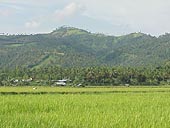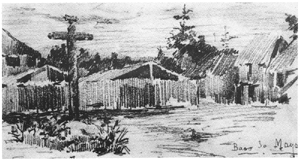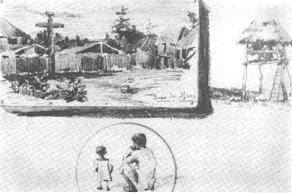|
| Baao, Camarines Sur, Philippines | ||
|
Archeological evidence and oral history tells of commerce flourishing in these early settlements as Baaoeños traded among themselves and with other people from foreign lands. Agtas bartered forest products such as honey, rattan and wild boar meat for the lowlanders' rice, salt, cooking pots and pieces of clothing. Porcelain pottery shards found in Binanuaanan of 14th to 18th century mainland Chinese origin may indicate contacts with foreign peoples or the extent of trade long before the coming of the Spaniards. The Spanish Occupation Era When the Spaniards conquered the Philippines in the 16th century, they found these settlements already existing in their original areas with people living a way of life different from their Western culture. Viewing the native culture as a strange mumbo-jumbo and with the flair of a cocky fanatic, the Spaniards launched a campaign to convert the once animist Baaoeños to Catholicism. Indigenous beliefs were suppressed and branded as satanic. Written records in native script and native artworks were burned as the Spanish friars and their cohorts blinded the Baaoeños with fear of fire and brimstone in hell while robbing them of their lands. In the 17th century, the Baao settlement was considered by the Spaniards merely as a barrio of
Since politico-administrative power rested on the parish priest in the early part of the Spanish rule, the Baaoeños literally lived at the mercy of the friars on both the temporal and spiritual matters. But the curates did not have to be physically cruel to these people to make them easily governable. Exploiting the natural religiosity of the Baaoeños, which until now is very apparent, the friars' sermons left the people enthralled with the Judeo-Christian beliefs and the promise of a heavenly afterlife after a lifetime of suffering. Thus, when the friars told them to move the town center (i.e. the Catholic church) to higher and less flood-prone grounds, the Baaoeños did unflinchingly, twice.
The livelihood of the Baao people during this era was still very much alike as before. Fishing and rice farming according to the season; only on a much larger scale as the municipality struggled to provide enough food to a growing population
|
||
|
|


 Early Baao settlement as depicted by the bodyguard of Dr. Jose Rizal, Jose Taviel de Andrade, when he visited the area in the early 1800s
Early Baao settlement as depicted by the bodyguard of Dr. Jose Rizal, Jose Taviel de Andrade, when he visited the area in the early 1800s More of the illustration depicted above with sitting figures in the foreground and a hut on stilts on the background.
More of the illustration depicted above with sitting figures in the foreground and a hut on stilts on the background.